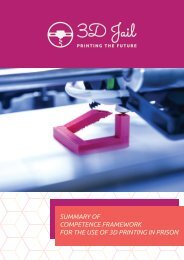3D Jail Project - IO1 - Competence framework for 3D printing in jail
Intellectual Output 1 The main innovative element of IO1 is to entail professionalizing competencies on the use of 3D printing technologies in the learning context of people with fewer opportunities because of their status of prisoners, ex-prisoners or subjected to alternative measures to detention. It is innovative because – in a pioneering way in Europe – it puts the basis to frame this kind of competencies in relation with restricted people, in the context of prison security, and it challenges penitentiary administrations to innovate their procedures and conditions to use even more ICT technologies inside their structures. It also poses prisons’ educational systems before the challenge to include these specific competencies in the educational experience of the inmates.
Intellectual Output 1 The main innovative element of IO1 is to entail professionalizing competencies on the use of 3D printing technologies in the learning context of people with fewer opportunities because of their status of prisoners, ex-prisoners or subjected to alternative measures to detention. It is innovative because – in a pioneering way in Europe – it puts the basis to frame this kind of competencies in relation with restricted people, in the context of prison security, and it challenges penitentiary administrations to innovate their procedures and conditions to use even more ICT technologies inside their structures. It also poses prisons’ educational systems before the challenge to include these specific competencies in the educational experience of the inmates.
- No tags were found...
You also want an ePaper? Increase the reach of your titles
YUMPU automatically turns print PDFs into web optimized ePapers that Google loves.
Study of the processes of validation and applicable<br />
certifications <strong>in</strong> Europe<br />
Recognition of competencies, validation processes and certification<br />
The construction of a European Area of Skills and Qualification (EASQ) 5 has been ongo<strong>in</strong>g<br />
s<strong>in</strong>ce the beg<strong>in</strong>n<strong>in</strong>g of the century, aim<strong>in</strong>g to make skills and competencies more and more<br />
recognized <strong>in</strong> any of the European countries. Mobility and lifelong learn<strong>in</strong>g aims have seen<br />
the use of different transparency tools <strong>in</strong> order to make experiences and qualification more<br />
and more recognized all over Europe.<br />
Still the European Vocational Educational Tra<strong>in</strong><strong>in</strong>g (VET) system has different structures and<br />
the number of different qualification and qualification levels does not allow an immediate<br />
and official correspondence.<br />
In short:<br />
● S<strong>in</strong>ce 2002<br />
○<br />
○<br />
○<br />
Transparency tools: recognition documents (such as diploma supplement,<br />
European CV, Europass, etc.)<br />
Experimentation <strong>for</strong> the qualification mutual recognition (such as ECVET<br />
(European Credit system <strong>for</strong> Vocational Education and Tra<strong>in</strong><strong>in</strong>g)<br />
Quality of tra<strong>in</strong><strong>in</strong>g<br />
● 2008 - 2017<br />
○<br />
○<br />
European qualification <strong>framework</strong> (EQF) - 8 levels descriptors: Knowledge,<br />
skills, and responsibility/autonomy<br />
National qualification <strong>framework</strong> – referenc<strong>in</strong>g reports<br />
● 2012<br />
○<br />
validation of non-<strong>for</strong>mal and <strong>in</strong><strong>for</strong>mal learn<strong>in</strong>g<br />
5 For EASQ, EU policies and <strong>in</strong>struments should:<br />
●<br />
●<br />
●<br />
●<br />
●<br />
Be coherent and centred on the learner, promot<strong>in</strong>g flexible learn<strong>in</strong>g pathways,<br />
Support new phenomena such as the grow<strong>in</strong>g use of digital learn<strong>in</strong>g and <strong>in</strong>ternationalisation of<br />
education<br />
Provide better services to learners and workers<br />
Be simpler, better understandable and more coherent<br />
Support national structural re<strong>for</strong>ms that aim to achieve these objectives.<br />
32





